When it comes to metal detecting, having a reliable pinpointer is crucial for maximizing your finds. This review highlights some of the best pinpointers available from reputable brands, aiming to save you both time and money. By reading this article, you’ll gain insights into various models tailored to meet your specific requirements and search conditions. The market offers a diverse selection of pinpointers – approximately 24 different options that can significantly enhance the efficiency of any detectorist. Whether you’re a beginner seeking an entry-level device or an experienced user looking for advanced features, this guide will help you make an informed choice.

Contents
Best pinpointers
The list features eight expertly chosen pinpointer models, providing a diverse range to address most tasks encountered during treasure hunting. Each model is designed with specific features to meet different needs, ensuring you have the right tool for various scenarios. Additionally, our website includes a detailed article describing each of the devices on the list, offering further insights into their capabilities and how they can enhance your treasure-hunting experience.
Garrett Pro-Pointer II
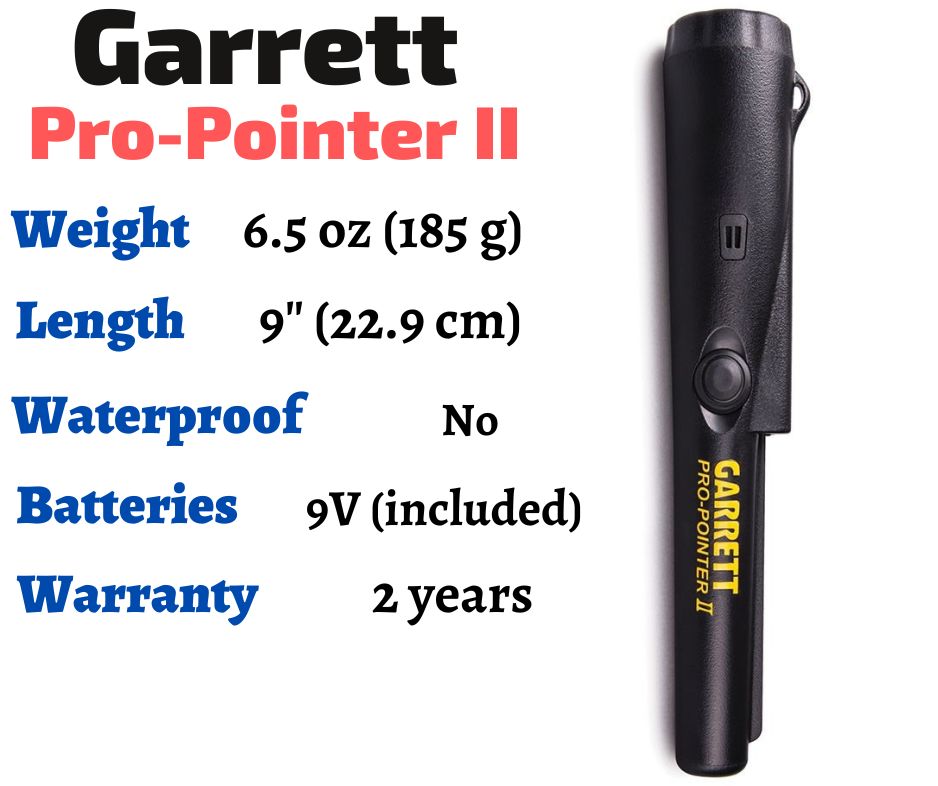
The Pro-Pointer II is an upgraded version of its predecessor, the Pro-Pointer I, featuring a variety of enhancements. This new model boasts an IP66 rating, making it an all-weather device that can withstand dust and moisture, though it is not submersible.
One notable improvement is the inclusion of a lost device alarm, which alerts users if the pinpointer is misplaced. Additionally, the Pro-Pointer II automatically shuts off if it remains stationary for a certain period, preserving battery life. While the device is damp-proof, it can safely endure exposure to running water, allowing for easy cleaning without risking damage.
- PINPOINT ACCURACY: 360° detection field locates targets with precision,…
- WATER-RESISTANT DESIGN: Meets IP66 standards—tip can be submerged, and unit…
- FAST RETUNE FUNCTION: Quickly tunes out mineralized ground, wet sand, or…
- LED FLASHLIGHT: Built-in light improves visibility in low-light conditions while…
- READY TO USE: Comes with a woven belt holster and a 9V battery, so you can start…
- Fully Waterproof: Submersible up to 20 feet, perfect for beach, river, and…
- Adjustable Sensitivity: Three levels for detecting small targets like gold…
- Fast Retune Feature: Instantly narrows detection field, tunes out mineralized…
- Simple One-button Control: Power, retune, sensitivity adjustment, and stealth…
- Built-In Ruler & Lanyard Loop: Molded inch/cm ruler for depth measurement and…
Last update on 2025-06-10 / Affiliate links / Images from Amazon Product Advertising API / Source: Amazon Affiliates
| Model | Garrett Pro-Pointer II |
| Weight | 6.5 oz (0.2 kg) |
| Length | 9″ (22.9 cm) |
| Batteries | 9V (included) |
| Warranty | 2 years |
| Operating Principle | VLF |
| Operating Frequencies (kHz) | 12 kHz |
| Water resistance | No. Weatherproof, splashproof |
| Discrimination | No |
| Ground Balance | No |
| Vibrating alert | Yes |
| Sensitivity – Depth Adjustments | No |
| Build-in flashlight | Yes |
Garrett Pro-Pointer AT
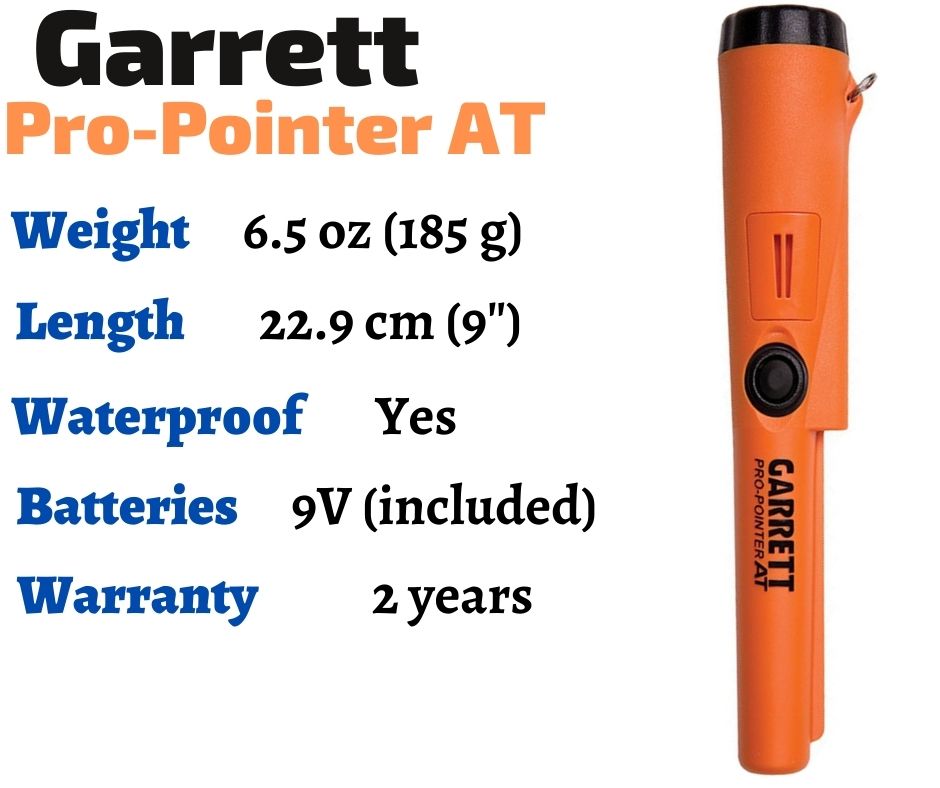
The Garrett Pro Pointer AT builds upon the features of the Pro-Pointer II, offering enhanced capabilities, including a submersible rating of up to 10 feet (3 meters) and three sensitivity levels. With an IP68 classification, this pinpointer is designed for maximum protection in challenging environments.
These design features allow users to search for objects in rivers, lakes, or seas with confidence. The bright orange color of the device makes it highly visible, reducing the chances of losing it in muddy water.
This pinpointer is a true multi-purpose tool, built to withstand rugged conditions, making it suitable for both beginners and experienced detectorists alike.
- Fully Waterproof: Submersible up to 20 feet, perfect for beach, river, and…
- Adjustable Sensitivity: Three levels for detecting small targets like gold…
- Fast Retune Feature: Instantly narrows detection field, tunes out mineralized…
- Simple One-button Control: Power, retune, sensitivity adjustment, and stealth…
- Built-In Ruler & Lanyard Loop: Molded inch/cm ruler for depth measurement and…
- FULLY WATERPROOF: Submersible up to 20 feet, perfect for beach, river, and…
- ADJUSTABLE SENSITIVITY: Three levels for detecting small targets like gold…
- FAST RETUNE FEATURE: Instantly narrows detection field, tunes out mineralized…
- SIMPLE ONE-BUTTON CONTROL: Power, retune, sensitivity adjustment, and stealth…
- COMPLETE HUNTING KIT: Includes Pro-Pointer AT, camo finds pouch, woven belt…
Last update on 2025-06-10 / Affiliate links / Images from Amazon Product Advertising API / Source: Amazon Affiliates
| Model | Garrett Pro-Pointer® AT |
| Length | 9″ (22.9 cm) |
| Thickness | 1.5″ (3.8 cm) tapered to .875″ (2.2 cm) |
| Weight | 6.5 oz (0.2 kg), with battery |
| Battery | Single 9V (included) |
| Battery life | 16 hours (carbon), 30 hours (alkaline), 8 hours (rechargeable) |
| Operating frequency | 11.5 kHz |
| Operating temperatures | -4°F (-20°C) to 130°F (54°C) |
| Waterproof | 20 foot (6 meter) maximum depth; IP 68 |
| Tuning | Automatic or manual retune |
| Indicators | Proportional audio/vibration pulse rate |
| Controls | Power, Retune, Adjust switch |
Minelab Pro-Find 35
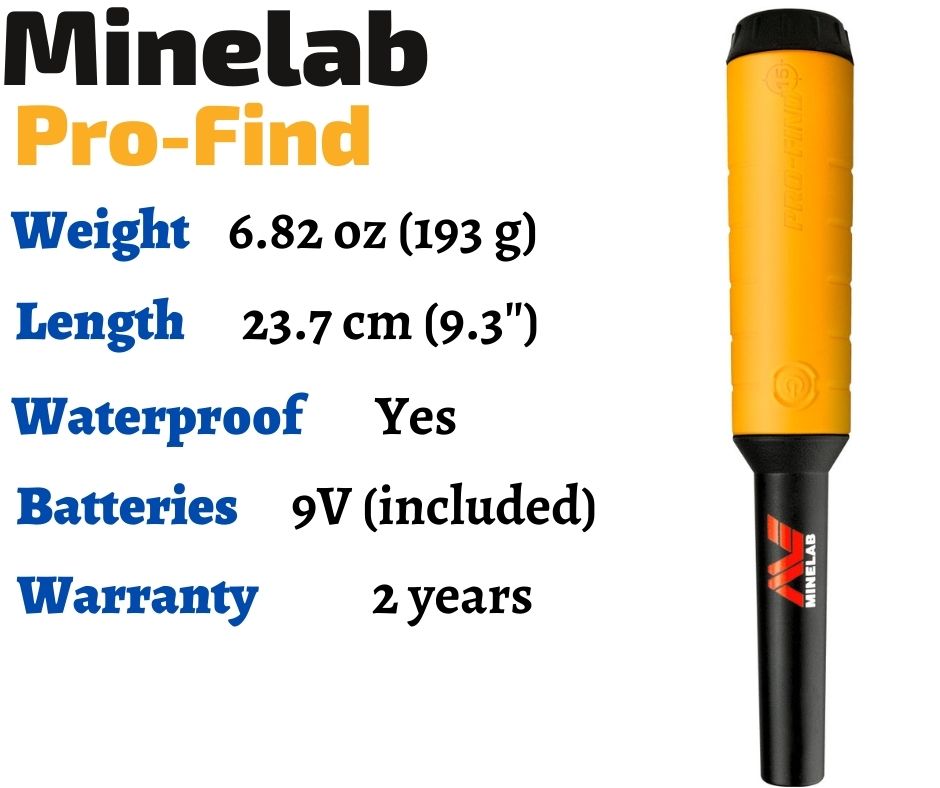
The Minelab Pro-Find 35 is a cutting-edge pinpointer model designed for ease of use, boasting advanced technology. It features five sensitivity levels, audio and vibration target identification, and metal discrimination, providing distinct signals for ferrous and non-ferrous metals. Its bright yellow casing enhances visibility, while practical features like a lanyard attachment hole and an inactivity alarm ensure that you won’t easily lose the device.
Notably, the Pro-Find 35 is the first pinpointer in the world to offer metal discrimination, allowing users to distinguish between metal types through different sound alerts. Additionally, this pinpointer is waterproof, submersible up to 10 feet (3 meters), making it ideal for various treasure-hunting environments.
For those seeking a more budget-friendly option, the Minelab Pro-Find 15 is available. While it serves as a cost-effective alternative to the Pro-Find 35, it has a more limited set of features. The Pro-Find 15 lacks an LED flashlight, vibration response, and variable tone signals, and it is not waterproof.
- DIF TECHNOLOGY. An essential part of your detection tool kit, the PRO-FIND 35…
- FULLY WATERPROOF. Don’t stop your search at the beach or the bank. This…
- FERROUS TONE ID. Add another layer of high-power performance, even with…
- ADJUSTABLE SENSITIVITY. 5 sensitivity levels allow you to maximize depth,…
- AUDIO & VIBRATION INDICATION: Intensifying vibrations accompany increasing audio…
- WATERPROOF DESIGN. Full waterproof housing allows this pinpointer to be…
- DIF TECHNOLOGY. Detector Interference Free (DIF) technology reduces interference…
- FERROUS TONE ID. Two different responses help distinguish ferrous junk from…
- 5 SENSITIVITY LEVELS. Adjust sensitivity to maximize depth, minimize noise and…
- AUDIO & VIBRATION INDICATION. Intensifying vibrations accompany increasing audio…
Last update on 2025-06-10 / Affiliate links / Images from Amazon Product Advertising API / Source: Amazon Affiliates
| Model | Minelab Pro-Find 35 |
| Weight | 6.82 oz (193 g) |
| Length | 23.7 cm (9.3″) |
| Batteries | 9V (included) |
| Warranty | 2 years |
| Operating Principle | VLF |
| Water resistance | Up to 3 m (10 ft) |
| Thickness | 1.5″ (3.8 cm) Tapered to .875″ (2.2 cm) |
| Discrimination | Audio, Vibration |
| Controls | Power, Retune, Adjust Switch |
| Ground Balance | No |
| Sensitivity | Adjustable (5 levels) |
| Build-in flashlight | Yes |
Nokta Pointer
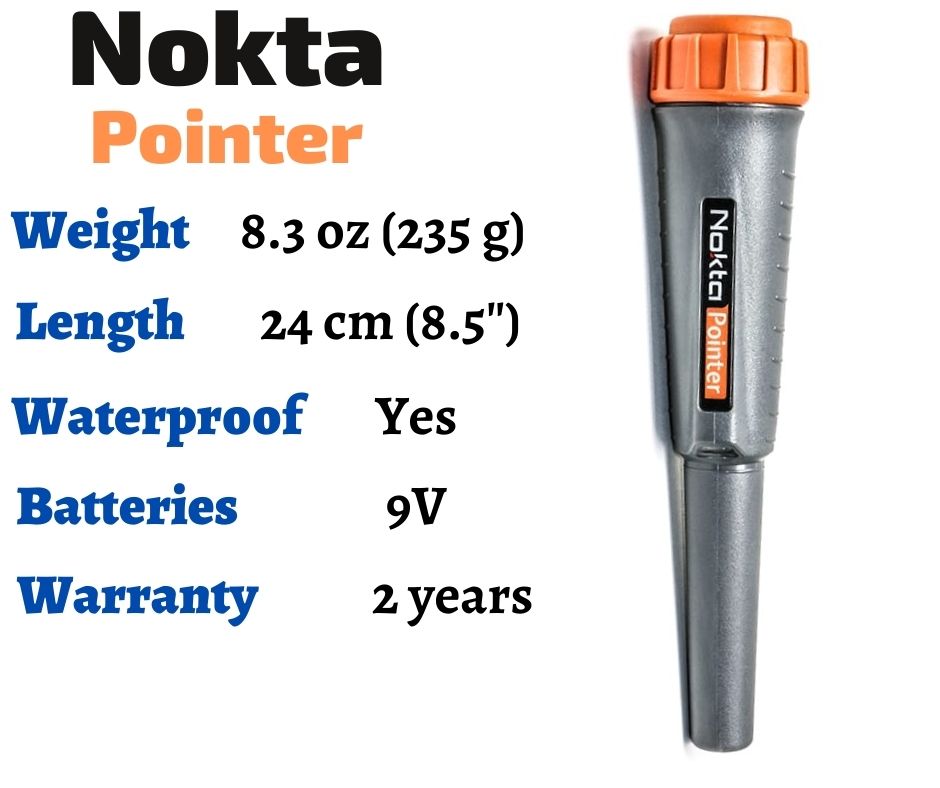
The Nokta Pointer is an affordable pinpointer produced by a Turkish company, designed for durability and efficiency in various environments. With an IP67 rating, this device is protected against dust, water, and other natural elements, making it suitable for outdoor use. It can even withstand submersion in water for up to a week without damage.
While the control buttons are located on the battery holder cap, which may be inconvenient for some users, this design aims to facilitate easy operation while submerged. The Nokta Pointer also features an alarm mode that doubles as an automatic shut-off function; if left inactive, it will turn off after five minutes to conserve battery life.
The device comes with an extensive package set that enhances its value. In addition to a quality battery, users receive a rigid carrying case with a shoulder strap for easy transportation. A holster is also included for convenient attachment to a belt, making it accessible during treasure hunts. Additionally, the standard package includes plastic protection caps for the working area and a soft neoprene pouch, which can be used to store the pinpointer or protect fragile finds.
- Nokta pointer can be used on land and under the sea.It has been designed to meet…
- 11.6 kHz frequency.
- Metal Detection Alarm: Audio and/or vibration.Adjustable: 4 levels of…
- Size:9.4 x 1.9 x 1.9 inches (24 x 4.8 x 4.8cm)
Last update on 2025-06-10 / Affiliate links / Images from Amazon Product Advertising API / Source: Amazon Affiliates
| Frequency | 11.6 kHz |
| Metal Detection | Audio Alert and/or Vibration |
| Sensitivity Adjustment | Manual |
| Coil Interface Blocking | Yes |
| Dimensions | 9.4″ x 1.9″ (24 x 4.8 cm) including the hard-shell digger case |
| Detection Tip | 3.7″ (9.3 cm) |
| Weight | 8.3 oz (235 gr) including the battery & hard-shell case |
| Working Temperature | -4 °F / +122 °F (-20 °C / +50 °C) |
| Battery | 9V Alkaline Battery |
| Battery Life | +30 hours |
| Warranty | 2 Years |
XP Mi-6
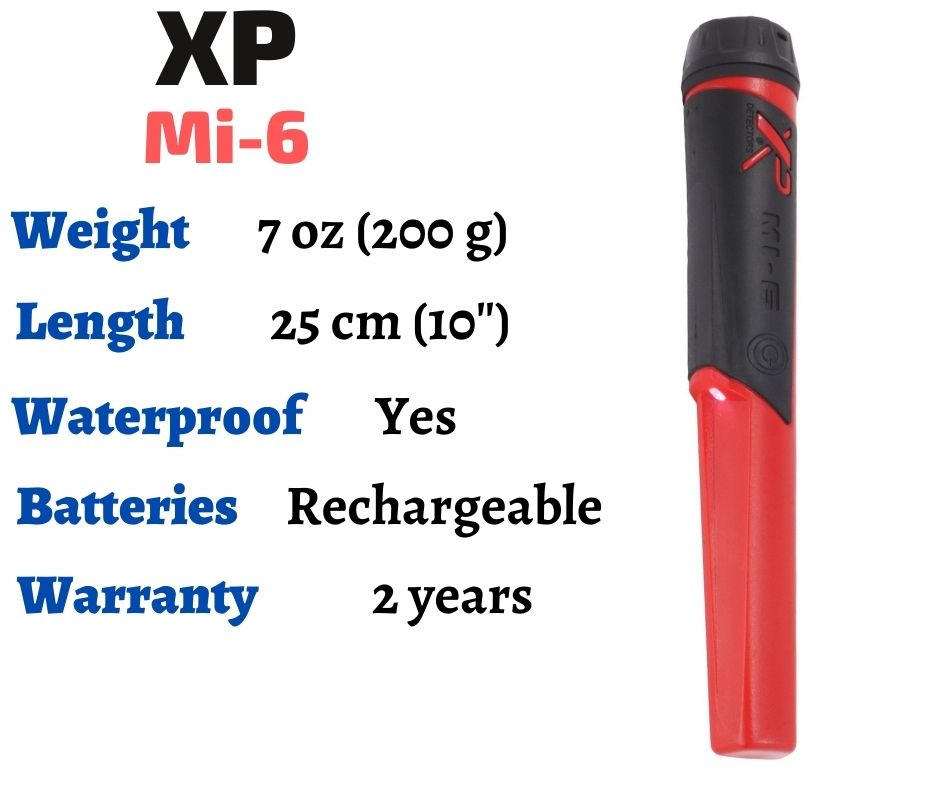
The XP Mi-6 is an outstanding pinpointer model, especially for users of XP Deus, XP ORX, or XP Deus 2 metal detectors. If you are fortunate enough to own an XP Deus, this pinpointer is likely the best option available to you.
When paired with XP metal detectors, users can take advantage of several key features:
- Sound indications can be heard through your headset, enhancing the treasure-hunting experience.
- The noise-cancel mode ensures that the pinpointer and metal detector operate without interference.
- With an impressive offline operation time of about 90 hours, the Mi-6 outlasts most other devices on the market by 3-4 times.
- The device offers 50 sensitivity levels, allowing for precise detection tailored to different environments.
If you do not own an XP metal detector, don’t worry! The Mi-6 can still be used as a standalone device, although some features may not be fully accessible.
The XP Mi-6 is designed for durability, being submergible up to 20 feet and capable of floating, so it won’t sink if accidentally dropped in water. It is powered by a lithium battery with a mini-USB charging port, which provides the convenience of charging through a car’s cigarette lighter or a mobile phone charger.
- 🎯 — AUDIO SIGNAL — Signal transmitted to your XP metal detector with a 10…
- 🎯 — WATERPROOF PINPOINTER — Use your pinpointer underwater up to 6 meters /…
- 🎯 — WIRELESS CONNECTIVITY — The MI-6 is the first pinpointer on the market…
- 🎯 — COMPATIBILITY WITH THE XP DETECTORS — Adjust the sensitivity of your…
- 🎯 — SETTINGS — Detection frequency up to 12 kHz with extended functions…
- 🎯 — BENEFITS — XP waterproof (up to 20 feet) and traditional pinpointer,…
- 🎯 — RETUNE — Re-calibrate the pinpointer when operating by briefly pressing…
- 🎯 — FREQUENCY — Detection frequency of 12kHz with 6 factory programs, 3…
- 🎯 — AUTONOMY — Advantages of the speaker and vibrator and/or led…
- 🎯 — BATTERY — Equipped with a rechargeable lithium polymer battery, comes…
Last update on 2025-06-10 / Affiliate links / Images from Amazon Product Advertising API / Source: Amazon Affiliates
| Model | XP MI-6 |
| Weight | 0,44 lbs (200 grams) |
| Length | 10 inches (25 cm) |
| Batteries | Lithium rechargeable battery |
| Warranty | 2 years |
| Operating Principle | VLF |
| Operating Frequencies (kHz) | 12 |
| Water resistance | Waterproof |
| Submersion Depth | 6 m / 20 ft |
| Audio | 2 audio modes |
| Discrimination | No |
| Ground Balance | No |
| Sensitivity | 50 levels |
| Vibrating alert | Yes |
| Build-in flashlight | Yes |
Quest XPointer Max
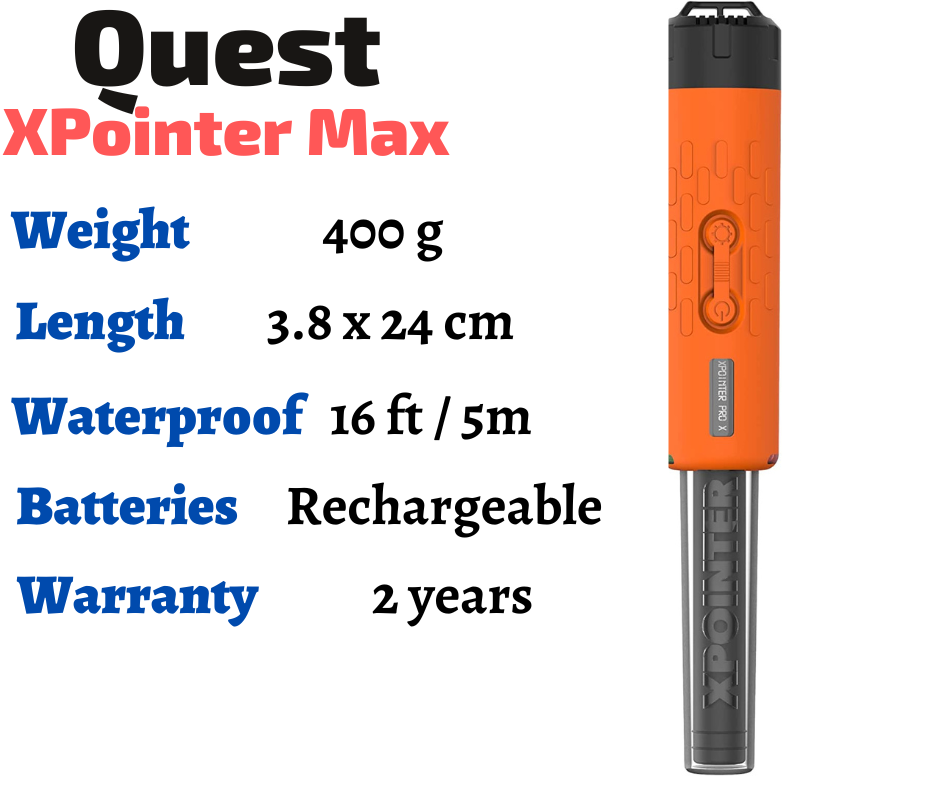
American manufacturer Quest Metal Detectors has launched the Quest XPointer Max, a cutting-edge pinpointer equipped with a metal discrimination function. This innovative device is completely waterproof and features an illuminated display and an internal battery, making it a reliable companion for treasure hunters.
One of the standout features of the XPointer Max is its ability to differentiate between ferrous and non-ferrous metals. The small illuminated display provides clear indications of the detected object’s metal type. As you approach your target, a scale on the display grows, visually indicating your proximity, while the intensity of the sound signals increases, providing an intuitive feedback mechanism.
This feature is particularly useful when searching in areas with mixed metal types, helping users avoid digging up unwanted items and enhancing the efficiency of their treasure-hunting expeditions.
- Magic Holster Technology: Effortless detection with the draw-out activation and…
- Discrimination Capability: Identify your target before digging for precision and…
- Waterproof Design to 15FT: Dive into underwater treasures with confidence, fully…
- Impeccable Audio Precision: Unmissable audio cues guide you towards your target,…
- High Sensitivity: Penetrate deeper and discover hidden treasures that others…
- LED/Buzzer/Vibration Alert While Detecting
- Li-Poly Battery Build Inside Shell
- 200ft/60m Waterproof Protection
- Easy to Use Two Button Control
- Target Locking Function with LED Light
Last update on 2025-06-10 / Affiliate links / Images from Amazon Product Advertising API / Source: Amazon Affiliates
| Operating Principle | VLF |
| Operating Frequency | 9.5 kHz |
| Waterproof | 16 ft / 5m |
| Detection Modes | Audio, Vibration, LED Beam Lights |
| Sensitivity | 4 Levels, LED flashlight, Re-tune (Once power on) |
| Length | 3.8 x 24 cm |
| Weight | 400 gr |
| Battery | 1000 mAh Li-Po Rechargeable Battery |
| Indicators | Battery Status, Lost Alarm |
| Warranty | 2 years |
Nokta PulseDive
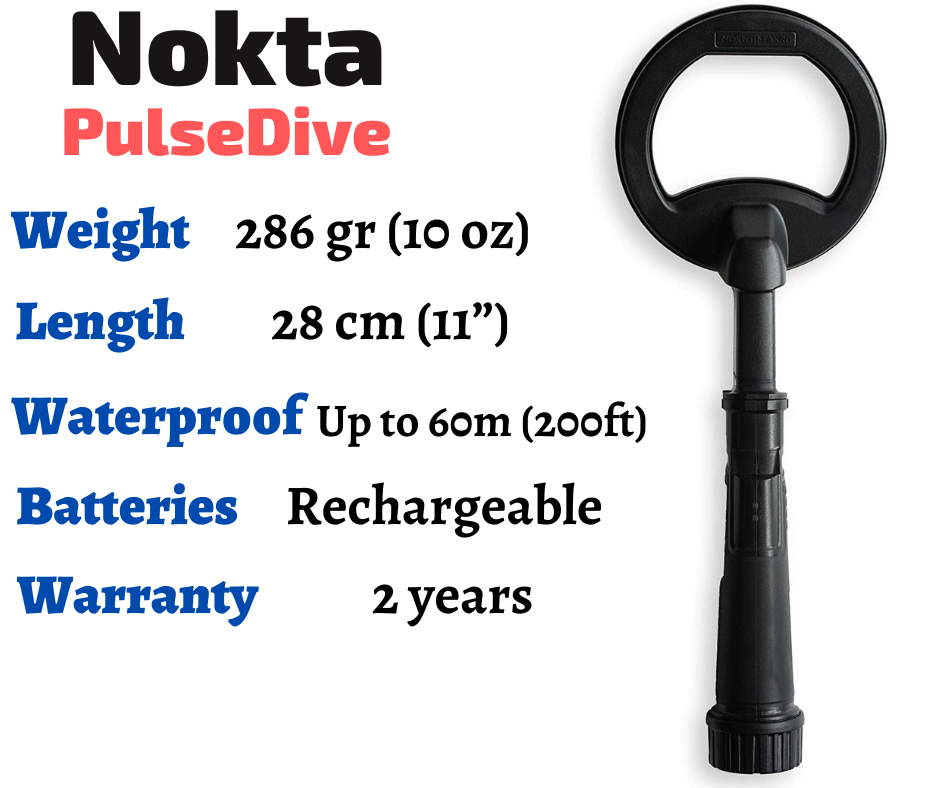
The Nokta PulseDive pinpointer features a pulse induction (PI) approach with an operating frequency of 3 kHz, making it highly effective in challenging environments. This technology ensures that the device remains unaffected by brackish water and highly mineralized soils, providing stable performance regardless of the terrain.
Designed for versatility, the pinpointer comes with a replaceable pointer coil, which has a diameter of 14 cm (5.5 inches), perfect for underwater treasure hunting. The package includes a dismountable hard-shell protection case for safe storage and transport, as well as a plastic protection case designed for ground searches.
To enhance durability, all replaceable components of the Nokta PulseDive pinpointer are equipped with specialized plastic protection cases, making them resistant to wear and tear during extensive use.
- Waterproof Metal Detector: Nokta Pulsedive metal detectors are waterproof up to…
- Lost Alarm: After 5 minutes of inactivity, the device emits an audible alarm and…
- Innovative Design: This innovative design allows for a quick transformation of…
- LED Flashlight: LED Flashlight Easily see your target at night or when hunting…
- Metal Detector Accessories, Package Contents:PulseDive Detector, Replaceable…
- Waterproof up to 60m (200ft.)
- Compatible with Nokta 2.4 GHz Green Edition Wireless Headphones.
- Lightweight & rugged with audio, LED light and vibration alerts!
Last update on 2025-06-10 / Affiliate links / Images from Amazon Product Advertising API / Source: Amazon Affiliates
| Operating Principle | Pulse Induction |
| Operating Frequency | 3kHz |
| Waterproof | Up to 60m (200ft.) |
| Detection Modes | Audio / Vibration / Audio + Vibration / LED |
| Sensitivity | 5 levels adjustable |
| Length | 28 cm (11”) |
| Weight | 286 gr (10oz) including the hard-shell case |
| Battery | 1650mAh Lithium Polymer |
| Charging Time | ≈2 hours |
| Warranty | 2 years |
Teknetics Tek-Point
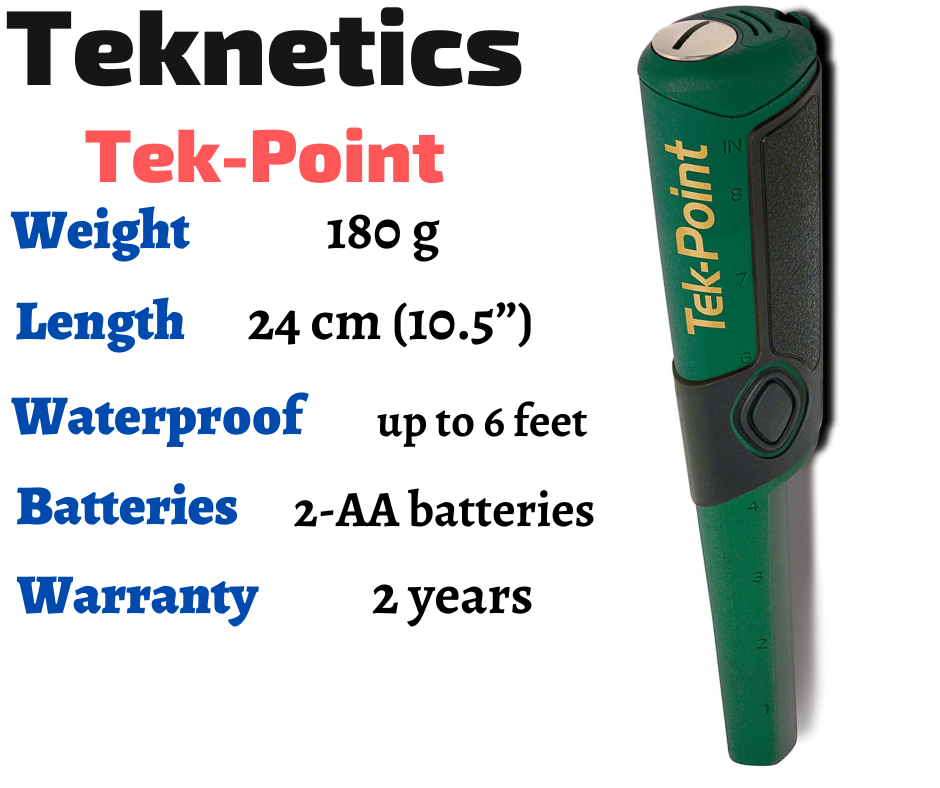
The Teknetics Tek-Point pinpointer, introduced in 2017 by the American metal detector manufacturer Teknetics, is designed to enhance the treasure-hunting experience with its user-friendly features. This pinpointer boasts three sensitivity modes, an adjustable flashlight, and both audio and vibro-signal target responses. Additionally, it offers a mixed mode that combines audio and vibration alerts for effective target detection.
Among its standout features are a lost mode that helps locate the device if misplaced and an automatic shutoff function to conserve battery life. The Tek-Point pinpointer is waterproof, ensuring reliable performance in various weather conditions.
The pinpointer’s durable casing and the use of standard AA batteries as a power source enhance its practicality. Users can enjoy manual frequency shifting to minimize interference from other devices, while the reliable metal cap of the battery holder adds to its overall durability.
- Pulse Induction Beep, vibrate or both Lost mode alarm Single button operation 3…
- Includes Tek-Point Pinpointer for Precision: This bundle comes with the…
- 11” DD Waterproof Coil for Depth & Coverage: The 11-inch DD waterproof…
- Iron Target Indicator & Fe Tone Adjustable Iron Audio: The Eurotek Pro features…
- Fast Recovery Speed & Excellent Target Separation: This detector is engineered…
- Customizable Settings for a Tailored Experience: Adjust sensitivity,…
Last update on 2025-06-10 / Affiliate links / Images from Amazon Product Advertising API / Source: Amazon Affiliates
| Model | Teknetics Tek-Point |
| Weight | 180 grams |
| Length | 240 mm x 45 mm x 35 mm |
| Batteries | 2 AA batteries (not included) |
| Battery life | AA Alkaline 25 hrs, NiMH rechargeable 15 hrs, Lithium 50 hrs |
| Warranty | 2 year |
| Operating Principle | Pulse Induction |
| Lost mode alarm | Yes |
| Water resistance | Yes |
| Submersion Depth | up to 6 feet |
| Discrimination | No |
| Ground Balance | Yes |
| Adjustable LED light | Yes |
| Auto shutdown | Yes |
| Proportional response | Yes |
| Single button operation | Yes |
What Is a Pinpointer?
A pinpointer is an essential tool for metal detecting, designed to help users locate targets with high precision. There are two types of pinpointers commonly referenced:
- Metal Detector Mode: This mode activates when a user presses a button on the metal detector. The device emits a signal that increases in strength as the search coil approaches the target.
- Standalone Pinpointer: This device is specifically designed to enhance target location accuracy. Unlike the metal detector mode, a standalone pinpointer provides efficient and precise detection.
Why Are Pinpointers Necessary?
Detecting small-sized targets can be a challenge for modern metal detectors equipped with Double D (DD) search coils. While DD coils have several advantages, they often struggle with accurately pinpointing the target center. This lack of precision can be frustrating for users who may not know how to properly locate a target with just the search coil.
Example Scenario: Suppose your metal detector signals a target. Using the pinpointer mode, you identify its center and dig out a clod of earth. You then need to check the hole for the target or search the clod itself, which can be tedious without a dedicated pinpointer.
With a pinpointer, you simply press a button to activate it, saving time and reducing effort while preventing potential damage to your finds. If the target remains in the hole, the pinpointer allows you to determine whether you need to dig deeper or work on the walls of the hole. If you’ve extracted a clod, you can quickly move the clod around with the pinpointer to locate the target.
Advantages of Using a Pinpointer
- Time Efficiency: A pinpointer significantly reduces the time spent locating a target, enabling you to uncover more finds in a shorter period.
- Less Physical Effort: Without a pinpointer, digging deeper or widening a hole can be labor-intensive. With a pinpointer, you can often retrieve the target in a single motion.
- Nighttime Treasure Hunting: Many pinpointer models come equipped with LED flashlights, allowing you to continue your search after dark and quickly find targets in the ground.

Effective Use and Maintenance of Your Pinpointer
A quality pinpointer typically has a 360-degree sensitivity area, but maximum detection depth is achieved only at the tip of the device. This means you should maneuver the pinpointer’s nose around the walls of the hole rather than using its lateral sides to locate targets effectively.
Battery Management
Before each treasure-hunting trip, check the battery charge. If you are using rechargeable batteries, it is advisable to recharge them to prevent any malfunction, such as constant beeping or reduced detection depth.
For pinpointers that use standard batteries, it is wise to carry a spare in your backpack. This precaution helps avoid the frustration of having your device turn off unexpectedly, rendering it ineffective during your hunt.
Searching Techniques
When searching within a hole using a pinpointer, maintain smooth movements. Sudden or forceful contacts with the walls may trigger signals unrelated to your target, leading to confusion.
It’s best to turn on the pinpointer outside of the hole. If activated near a metal object, the device may mistakenly identify it as a target and fail to react when encountering that type of metal until it is turned on and off again.
Operating in Humid Conditions
If you are operating in damp environments, ensure that water does not enter the service openings, such as speaker apertures, especially if your pinpointer is not waterproof.
Keeping Track of Your Pinpointer
During treasure hunting, it’s important to check on your pinpointer every 15 to 20 minutes. This regular check helps ensure you don’t stray too far from where you might have accidentally misplaced the device, giving you a better chance of recovering it.
Functions of a Pinpointer
A pinpointer is a straightforward device designed for effective metal detecting, primarily focusing on maximizing sensitivity. However, to distinguish between various brands, manufacturers often add unique features that enhance usability and functionality.
VLF vs. PI Technology
Pinpointers utilize different technologies, notably Very Low Frequency (VLF) and Pulse Induction (PI). For beach hunting or in highly mineralized ground, a pinpointer using PI technology is recommended, as it generates fewer phantom signals. In other scenarios, VLF models are generally sufficient.
Operation Modes
Most pinpointer models provide several operational modes, including:
- Audio + Vibration: Alerts the user with both sound and vibration, making it useful in noisy environments.
- Vibration Only: Ideal for silent operation, this mode relies solely on vibrations.
- Audio Only: Emits sound alerts when metal is detected, suitable for quiet areas.
Holster and Safety Lanyard
A holster and safety lanyard are essential accessories for any pinpointer. Failing to secure the lanyard can lead to the device being lost, as many users can attest. Not all models come with a lanyard, so it’s advisable to check and purchase one separately if needed.
Lost Pinpointer Alarm
This feature is common among many pinpointer models. After being turned on and then set aside for five minutes, the device will emit an alarm for 30 minutes before shutting off automatically. This feature can be useful but can be replaced by using a lanyard to keep the device secured.
Protection Class
Pinpointers can be categorized based on their protection class:
- Submersible: Ideal for underwater searches or beach hunting, with IP68 protection allowing submersion up to 50 meters deep.
- Non-Submersible: Suitable for land-based searches in parks and fields, where high protection from water isn’t necessary.
Automatic Adjustment Function
An automatic ground balancing function is a useful feature in some pinpointers. By simply pushing a button, the device can adjust itself to the surrounding ground conditions, enhancing its sensitivity and performance.
LED Flashlight
An integrated LED flashlight is a practical addition for night searches or underwater use. It provides necessary illumination without requiring an additional hand-held light source.
Internal Rechargeable Battery
Having an internal rechargeable battery is convenient, eliminating the need for purchasing standard batteries. However, this also means that users cannot replace the battery on the spot, and if the battery fails, the device may require professional servicing.
Sound Discrimination
Some pinpointers feature sound discrimination, which differentiates between ferrous and non-ferrous targets based on audio feedback. If the sound cuts out, it indicates a ferrous target; if it remains steady, the target is non-ferrous. While useful, this feature may not always be reliable, as the primary function of a pinpointer is to locate the exact position of a metal target, not to identify its composition.














